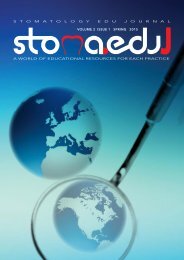Stomatology Edu Journal 1/2014
Create successful ePaper yourself
Turn your PDF publications into a flip-book with our unique Google optimized e-Paper software.
OROFACIAL<br />
Multi-/interdisciplinary<br />
PAIN<br />
approch<br />
Multi-/interdisciplinary approach<br />
Neurology<br />
Neurology<br />
Psychology<br />
Psychology<br />
Pain patient<br />
Pain patient<br />
Orthopedics<br />
Orthopedics<br />
Dentistry<br />
Dentistry<br />
U.T. Egle, Psychosomatik/Psychotherapie<br />
Figure 1. For patients with chronic headache, dental diagnostic and therapy are as valuable as that<br />
of other disciplines (taken from Egle, Mainz, 2000)<br />
U.T. Egle, Psychosomatik/Psychotherapie<br />
splints (6). Significant associations between CMD<br />
and frequent headaches were demonstrated in<br />
an epidemiological survey of over 4000 subjects<br />
in the Study of Health in Pomerania (SHIP) (4).<br />
In a diagnostically and therapeutically<br />
oriented dental follow-up study of patients<br />
whom neurologists and neurosurgeons had<br />
diagnosed with trigeminal neuralgia, Lotzmann<br />
et al. (7) found that in up to 50 % of the cases,<br />
CMD was the true cause of the neuralgic<br />
symptoms. Interestingly, over 70 % of these<br />
cases presented infraocclusion in the posterior<br />
dentition in centric relation, which was often the<br />
result of prostheses with insufficient height or<br />
orthodontic treatment.<br />
Craniofacial pain is frequently accompanied by<br />
temporomandibular joint (TMJ) and otological<br />
symptoms (8). The SHIP study showed correlations<br />
between tinnitus and CMD (9). Evaluating 200<br />
CMD patients who simultaneously suffered from<br />
tinnitus, earache, and dizziness, Wright (8) found<br />
that after successful treatment of masticatory<br />
functional disorders, these associated symptoms<br />
improved significantly.<br />
While interactions between CMD and<br />
unspecific headaches, tension headaches, and<br />
trigeminal neuralgia have been proven (4,7,10),<br />
the dental contribution to the etiology of<br />
migraine or migraine-like pain is controversial.<br />
Based on individual instances of successful<br />
dental treatment, particularly in cases of migraine<br />
symptoms unchangingly confined to one half<br />
of the face, some neurologists recommend a<br />
clinical dental consultation (11,12,13,14).<br />
Figure 2. In the Physiology of a healthy masticatory<br />
organ is characterized by receptors in the teeth,<br />
periodontium, muscles, and TMJs that transmit<br />
signals about the current status via afferent nerves<br />
(aff.N.) to the central nervous system. Based on this<br />
sensory information, a synaptic transformation to<br />
movement follows. Along efferent nerves (eff.N.),<br />
the corresponding motoric units of the musculature<br />
are activated, so that all masticatory functions can<br />
run in a coordinated manner<br />
Masticatory functional aspects<br />
Physiology<br />
During the growth of a healthy masticatory<br />
organ, the occlusal structures of all teeth<br />
and the TMJ adapt themselves to each<br />
other to follow a uniform geometry. Starting<br />
34 S T OMA.E D U J (<strong>2014</strong>) 1 (1)




